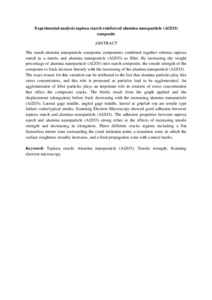Citation
Sarifudin, Jumardi and Mohd Shah, Mohd Kamal and Jaapar, Sahari and Salit, Mohd Sapuan
(2016)
Experimental analysis tapioca starch reinforced alumina nanoparticle (Al2O3) composite.
Journal of Built Environment, Technology and Engineering, 1.
pp. 181-195.
ISSN 0128-1003
Abstract
The starch-alumina nanoparticle composite components combined together whereas tapioca starch as a matrix and alumina nanoparticle (Al2O3) as filler. By increasing the weight percentage of alumina nanoparticle (Al2O3) into starch composite, the tensile strength of the composite to frack increase linearly with the increasing of the alumina nanoparticle (Al2O3). The exact reason for this variation can be attributed to the fact that alumina particles play like stress concentrators, and this role is promoted as particles lead to be agglomerated. An agglomeration of filler particles plays an important role in creation of stress concentration that effect the composite cracks. The brittle result from the graph applied and the displacement (elongation) before frack decreasing with the increasing alumina nanoparticle (Al2O3). Lateral gage middle, angled gage middle, lateral at grip/tab top are tensile type failure codes/typical modes. Scanning Electron Microscopy showed good adhesion between tapioca starch and alumina nanoparticle (Al2O3). The adhesion properties between tapioca starch and alumina nanoparticle (Al2O3) strong relate to the effects of increasing tensile strength and decreasing in elongation. Three different cracks regions including a flat featureless mirror zone surrounding the crack initiation point, a transition zone, in which the surface roughness steadily increases, and a final propagation zone with conical marks.
Download File
![[img]](http://psasir.upm.edu.my/54230/1.hassmallThumbnailVersion/Experimental%20analysis%20tapioca%20starch%20reinforced%20alumina%20nanoparticle%20%28Al2O3%29%20composite.pdf)  Preview |
|
Text
Experimental analysis tapioca starch reinforced alumina nanoparticle (Al2O3) composite.pdf
Download (6kB)
| Preview
|
|
Additional Metadata
Actions (login required)
 |
View Item |

